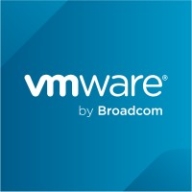![Cisco HyperFlex HX-Series [EOL] Logo](https://images.peerspot.com/image/upload/c_scale,dpr_3.0,f_auto,q_100,w_64/0dra2w8zbx5vrvwmhkdswx9l90ys.jpg)

VMware vSAN and Cisco HyperFlex HX-Series [EOL] compete in the hyperconverged infrastructure category. Based on feature versatility, VMware vSAN seems to hold the upper hand for scalable environments and ease of integration with various virtual tools.
Features: VMware vSAN offers scalable performance using commodity hardware, efficient storage policy management, and high workload efficiency. It integrates well with VMware ecosystems and excels in using policy-based storage management. Cisco HyperFlex HX-Series integrates compute, storage, and networking into an all-in-one solution with a seamless integration within Cisco environments, offering robust performance and simplicity in management.
Room for Improvement: VMware vSAN requires enhanced hardware compatibility and better integration with diverse platforms. Users also seek simplified backup and monitoring capabilities. Cisco HyperFlex HX-Series could improve by expanding its integration with non-Cisco platforms and refining scalability features. Both solutions could become more intuitive and streamlined in user interface and management.
Ease of Deployment and Customer Service: VMware vSAN is noted for easy on-premises deployment with commendable customer service, though some support escalation challenges exist. Cisco HyperFlex HX-Series is easy to deploy in Cisco-centric ecosystems with continuity in support, but faces compatibility challenges outside of those environments. Both solutions offer valuable support but could further streamline it for varied infrastructures.
Pricing and ROI: VMware vSAN is seen as costly, especially for SMBs, justified through its stability and scalable advantages offering significant ROI by cutting operational overhead. Cisco HyperFlex HX-Series [EOL] has a hefty initial price, matched by offering a comprehensive solution and reducing management complexity for longer-term ROI. Improvements in cost-efficiency could enhance competitiveness for both solutions.


| Company Size | Count |
|---|---|
| Small Business | 24 |
| Midsize Enterprise | 17 |
| Large Enterprise | 57 |
| Company Size | Count |
|---|---|
| Small Business | 98 |
| Midsize Enterprise | 58 |
| Large Enterprise | 128 |
The Cisco HyperFlex HX Data Platform is a purpose-built, high-performance, scale-out file system with a wide array of enterprise-class data management services. The data platform’s innovations redefine distributed storage technology, giving you complete hyper-convergence with enterprise storage features:
VMware vSAN is a software-defined storage product that is used in collaboration with VMware ESXi hypervisor and that provisions and manages storage based on policies, regardless of the underlying hardware. The solution enables you to prime your business for growth through its seamless evolution (it is integrated with vSphere and requires no new tools), its flexibility, and its multi-cloud capabilities. As an industry-leading software, VMware vSAN provides high levels of performance with minimal impact on CPU and memory.
VMware vSAN Features
VMware vSAN has many valuable key features. Some of the most useful ones include:
VMware vSAN Benefits
There are many benefits to implementing VMware vSAN. Some of the biggest advantages the solution offers include:
Reviews from Real Users
Below are some reviews and helpful feedback written by PeerSpot users currently using the VMware vSAN solution.
PeerSpot user Yves S., CEO, Cloud Evangelist at Comdivision Consulting GmbH, says, “vSAN gives us a lot of advantages when we need to expand resources. We have an overall larger host infrastructure, and we split that up for specific customer test and use cases. In that specific scenario, we can easily add more hosts or reduce the number of hosts in the environment.”
A reviewer who works in Infrastructure Security explains, “The ease of use is great. The initial setup and upgrade process was pretty straightforward. And, technical support is great.”
Laurent N., Director at Softlogic, comments, "The feature that I have found most valuable is that it is easy to deploy. It is easy to create and delete virtual servers. It is easy to create the load balancing and the clustering."
We monitor all HCI reviews to prevent fraudulent reviews and keep review quality high. We do not post reviews by company employees or direct competitors. We validate each review for authenticity via cross-reference with LinkedIn, and personal follow-up with the reviewer when necessary.